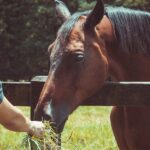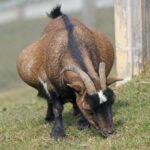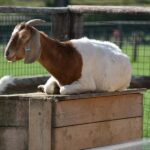Table of Contents
Goat owners often confront various health issues in their herds, but few conditions are as commonly misunderstood as goat bloat and hay belly.

While both conditions impact the appearance and comfort of the goat’s abdomen, they stem from different causes, exhibit distinct symptoms, and require separate management strategies.
This article aims to dissect these two conditions across several criteria to offer a clear, detailed comparison, aiding goat owners in recognizing, treating, and preventing each condition.
Understanding the Basics
Definition and Causes
Goat bloat is a serious condition characterized by the abnormal accumulation of gas within the goat’s rumen, leading to a swollen and tight abdomen.
It is primarily caused by the fermentation of certain feeds in the stomach, creating gas faster than it can be expelled.
Factors contributing to bloat include overeating on leguminous forages such as clover or alfalfa, sudden changes in diet, and consuming large amounts of grain.
On the other hand, hay belly refers to an expanded abdomen resulting from the consumption of large quantities of dry, fibrous materials like hay.
Unlike bloat, a hay belly does not involve the painful accumulation of gas but rather an excess of undigested roughage that stretches the belly.
It’s more common in scenarios where goats are fed low-quality hay that’s hard to digest or when their diet lacks proper nutritional balance.
Common Symptoms
The most evident symptom of goat bloat is a visibly swollen left side of the abdomen, which feels tight and drum-like upon tapping.
Goats with bloat may also appear restless, grind their teeth, have difficulty breathing, and show a decrease in appetite. In severe cases, if not promptly treated, bloat can be fatal.
Hay belly presents a very different picture. Goats with hay bellies have a uniformly distended abdomen, giving them a pot-bellied appearance.
However, unlike bloat, the distension is soft and not accompanied by the acute discomfort typical of bloat. Affected goats remain alert and active, with normal eating and bathroom habits.
Impact on Goat Health
Short-Term Effects
In the short term, goat bloat poses a significant health risk, potentially leading to death within hours if untreated due to pressure on the diaphragm that impedes breathing.
Immediate intervention is crucial to relieve pressure and prevent further complications.
Conversely, a hay belly doesn’t generally cause immediate distress or life-threatening issues.
The condition is uncomfortable for the goat and may indicate poor nutritional management, but it lacks the urgency associated with bloat.
Long-Term Consequences
If repeatedly experienced without proper management, bloat can lead to chronic digestive issues and reduce a goat’s overall productivity and growth potential.
While hay belly itself doesn’t usually result in long-term health problems, persistently feeding goats low-quality hay without addressing their nutritional needs can lead to malnutrition and associated health concerns over time.
Diagnostic Approaches
Visual and Physical Examination
Bloat is identified by a lopsided swelling on the goat’s left side, where the rumen is located, along with signs of distress. Palpation reveals a tight, gas-filled rumen.
In contrast, a hay belly causes a general, even expansion of the abdomen. The belly feels soft and doughy, and the goat does not exhibit signs of pain upon palpation.
Veterinary Diagnostic Tools

Veterinarians might employ stethoscopes to listen for rumen activity in cases of bloat, assessing for decreased or absent gut sounds indicative of severe gas accumulation.
Blood tests may also help determine the severity of the condition.
For hay belly, a thorough dietary history and physical examination are generally sufficient for diagnosis, with further tests rarely needed unless underlying nutritional deficiencies are suspected.
Treatment Options
Immediate Interventions
Treating bloat involves immediate veterinary intervention to relieve gas pressure, often through oral administration of anti-foaming agents or, in severe cases, rumen puncture to release gas.
Management of hay belly focuses on adjusting the diet to include higher quality forage and reducing reliance on dry, fibrous feeds, gradually correcting the condition without the need for emergency treatments.
Long-term Management and Care
Preventing future episodes of bloat requires dietary management, careful introduction of high-risk feeds, and possibly the use of preventative feed additives.
For hay belly, ensuring a balanced diet that meets all nutritional requirements, along with regular monitoring of the goat’s condition and gut health, are key to long-term management.
Prevention Strategies
Dietary Management
Both conditions highlight the importance of dietary management in goat care.
Preventing bloat involves carefully balancing the diet to include appropriate amounts of roughage and concentrate, avoiding sudden changes in diet, and providing bloat-preventive products when necessary.
To prevent hay belly, focus on providing high-quality hay, supplementing with adequate grains and minerals to ensure nutritional needs are met, and allowing goats access to pasture for natural foraging.
Environmental and Lifestyle Modifications
Enhancing the living environment and lifestyle can also play a role in prevention.
Ensuring goats have plenty of space to roam and exercise can aid digestion and prevent overeating, reducing the risk of both bloat and hay belly.
Regular health check-ups and maintaining a clean, stress-free living environment contribute to overall gut health and well-being, further mitigating the risk of these conditions.
Recovery and Monitoring
Signs of Improvement
Recovery from bloat is marked by a reduction in abdominal swelling, return of normal rumen sounds, and resumption of regular eating and defecation patterns.
Improvement in the hay belly is seen as a gradual decrease in abdominal distension, improved coat condition, and increased vitality as nutritional deficiencies are corrected.
Ongoing Care and Observation
Continuous observation is essential to ensure full recovery and prevent recurrence.
For bloat, closely monitor the goat’s diet, watch for early signs of distress, and maintain a slow, steady introduction of risky feeds.
In hay belly cases, ongoing dietary adjustments and monitoring of the goat’s general health and condition are crucial to ensure the issue does not recur.
Environmental Factors and Their Effects

Seasonal Variations
Seasonal changes can significantly influence the risk of both goat bloat and hay belly but in different ways.
During spring, the rapid growth of lush, leguminous pastures increases the risk of bloat as goats are likely to ingest large amounts of these fermentable feeds quickly.
Conversely, hay belly is more commonly seen in winter when goats are fed more dry, fibrous feeds due to the scarcity of fresh forage.
Understanding these seasonal risks can help owners adjust feeding practices and monitor their goats more closely during high-risk periods.
Access to Forage and Water
The availability of fresh forage and clean water plays a crucial role in preventing both conditions.
Goats with ample access to a variety of forages are less likely to suffer from bloat since their diets are not limited to just one or two highly fermentable plant types.
Similarly, sufficient forage diversity helps prevent hay belly by ensuring goats receive a balanced diet rich in nutrients, reducing their reliance on low-quality hay.
Adequate water intake is essential in both cases to aid digestion and reduce the risk of digestive disturbances.
Conclusion
While goat bloat and hay belly may present similarly with an enlarged abdomen, understanding their distinct causes, symptoms, and management approaches is essential for effective care.
Bloat demands urgent action to prevent fatal outcomes, whereas hay belly calls for a review and improvement of dietary practices.
Proper prevention, timely recognition, and appropriate interventions are key to maintaining the health and productivity of goats, safeguarding them against these and other health challenges.








